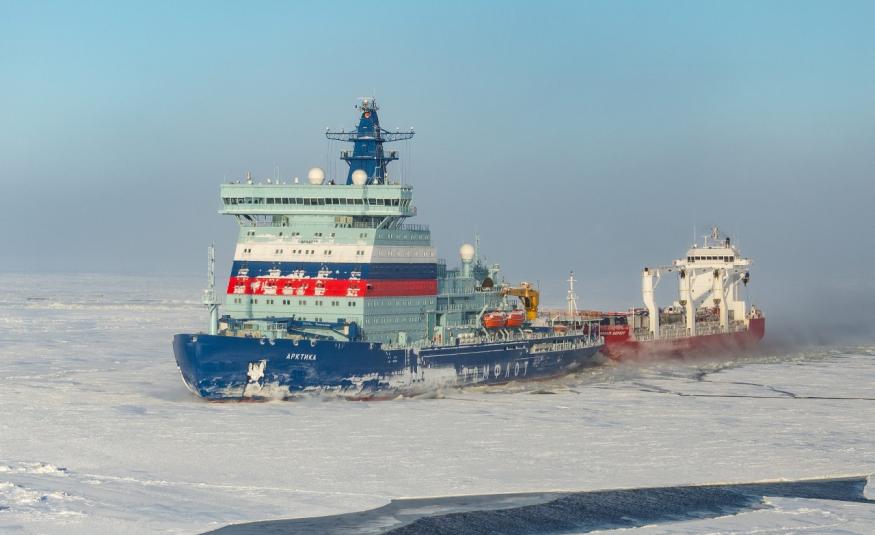President of the Russian Federation Vladimir Putin officially started the keel laying ceremony: “Russia today has a unique, I want to emphasize this, unique and the largest icebreaker fleet in the world.
"And this gives us a huge competitive advantage, enormous opportunities for the development of logistics, industry, as well as for the creation of new jobs, the integrated development of Arctic cities and towns, for the implementation of truly global projects, for international cooperation with our partners, friends, with everyone who wants and is willing work with Russia."
Alexey Likhachev, Rosatom Director General, said that the further development of the Northern Sea Route (NSR) necessarily involves the Arctic shipbuilding expansion. “A large number of high ice-class cargo ships will be required in the near future.
"The Arctic shipbuilding is turning into a strategically important area for Russia with Rosatom being not only a customer, but also participating in this work,” remarked Alexey Likhachev expressing his belief that the Leningrad icebreaker will make its contribution to the area development.
There are three nuclear-powered icebreakers of project 22220 in operation - the lead universal nuclear-powered icebreaker Arktika (commissioned in 2020), the first serial universal nuclear-powered icebreaker Sibir (commissioned in 2021) and the second serial universal nuclear-powered icebreaker Ural (commissioned in 2022).
The 3d serial universal nuclear-powered icebreaker Yakutia (commissioning scheduled for December 2024) and the 4th serial universal nuclear-powered icebreaker Chukotka (commissioning scheduled for December 2026) are under construction.
Project 22220 icebreakers are constructed based on innovative solutions. The nuclear icebreaker is equipped with RITM-200, new generation reactor plant.
This is a completely Russian product having no foreign counterparts and meeting modern development trends in the global nuclear energy.
The icebreaker double-draft design makes it possible to operate the vessel both in Arctic seas and at the mouths of polar rivers, in particular, in shallow waters of the Yenisei (Dudino direction) and the Ob Bay.
The development of navigation along the Northern Sea Route contributes to the resilience of global supply chains.
Shortest shipping route
The Northern Sea Route (NSR) is the shortest shipping route connecting the western part of Eurasia and the Asia-Pacific region.
In order to meet the demands of the intensifying traffic along the Northern Sea Route, Rosatom is implementing a program to replenish the nuclear icebreaker fleet with new vessels.
The universal nuclear icebreakers are to ensure safe navigation of ships of a DP World-Rosatom joint venture in the years ahead. It is planned to transport up to 800 thousand TEU of cargo a year along the Northern Sea Route. To fulfil this task, Rosatom will build a series of Arctic-class container ships. With already completed parameter studies, they are making contracts for the design of the future vessels.
The cargo shipping along the NSR reached a record high of 2.1 million tons in 2023. The implementation of the above plans for the construction of container ships as well as the traffic intensification within the joint venture will ensure increase of this figure.
The integrated development of the Russian Arctic is a national strategic priority. To increase the NSR traffic is of paramount importance for fulfilling the tasks set in the cargo transportation and delivery area.
This logistics corridor is being developed due to cargo shipping on a regular basis, construction of new nuclear icebreakers and modernization of the relevant infrastructure. Rosatom companies are actively involved in this work.
Main characteristics of the universal nuclear icebreaker of project 22220: length - 173.3 meters (160 meters along the design waterline); width - 34 meters (33 meters, the design waterline); side height - 15.2 meters, power - 60 MW (on shafts); speed - 22 knots (in clear water), draft - 10.5 meters/9.03 meters; maximum icebreaking capability – up to 3 meters; displacement - 33,540 tons; design service life - 40 years; crew size - 54 people. - DagangNews.com










